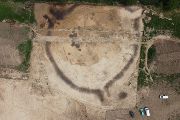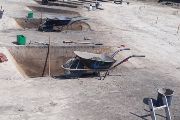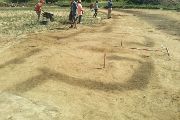
Archaeologists uncover a unique Stone Age building on the outskirts of Prague
29. 09. 2022
Prehistory literally in front of our eyes. A monumental Stone Age building, the so-called roundel, has been researched by scientists in Prague-Vinoř since July. Research into the nearly seven thousand-year-old circular architecture has so far revealed exceptionally well-preserved remains and an unusual floor plan with three entrances. The extent of the fieldwork is also unique: archaeologists are gradually going to uncover the structure almost in its entirety.
Roundels, monumental circular structures between 30 and 220 metres in diameter, are known to number around 200 in Europe. Their shape and size are reminiscent of, for example, the world-famous Stonehenge, but they are roughly 1,500 years older.
"The roundel in Vinoř has a diameter of 55 m and is unusual in its layout, as it is one of the few with three entrances," says Miroslav Kraus, the head of field research at the Institute of Archaeology of the CAS, Prague.
Besides, the scientists were surprised by the completely preserved remains of the palisade troughs into which the central wooden structure was originally embedded. "Usually only the remains of a trench or even several trenches that originally surrounded the wooden structure inside the central part of the roundel are found. The survival of the three troughs is largely a surprise to us, as the original terrain has changed significantly over the last seven thousand years," the archaeologist points out.
The extent of the excavation work in the field is absolutely unique. Currently, blocks of flats are being built in the field near Vinoř, so it will be possible to discover the roundel almost in its entirety. "I suppose that we will get to about 90% of the total ground plan, which is an extraordinary opportunity for archaeology. Only about ten rondels have been uncovered in Europe in this way," explains Jaroslav Řídký from the Institute of Archaeology of the CAS in Prague, who has long been involved in the subject of roundels.
The discovery from the 1980s
The roundel in Vinoř was discovered in the 1980s during the construction of utility networks. Scientists had the opportunity to examine a small part of it during further rescue research ten years later. The interdisciplinary research then continued with geophysical measurements of the overall form of the structure and its immediate surroundings.
The results so far indicate that it is a circular structure with a diameter of about 55 m, consisting of a single trench with a pointed bottom and three circular troughs in the area enclosed by the trench. There are three entrances to the centre of the structure, emphasised by the trench extending outwards from the site - facing north, south-west and south-east.
A mystery from 7,000 years ago
The original form of the roundels has long been disputed. What is known, however, is that there was a beam construction inside, anchored in troughs and surrounded by one to a maximum of four trenches. On the outside of the trench or trenches, there was most probably a mound, piled up with excavated material.
There were two, three, or most often four entrances (but exceptionally also five or six ones) leading into the centre. “If two entrances are documented, they are located to the east and west of the centre of the roundel, while in the case of four entrances they are more or less directed towards the cardinal points," explains Jaroslav Řídký.
According to radiocarbon-dated objects found in the trenches, all currently known roundels date from the period 4850-4700/4600 BC and have been documented in the environment of several archaeological cultures. They are therefore the oldest special (monumental) buildings in Europe.
The roundel in Vinoř is important because scientists are systematically researching almost its entire area, and it will thus be possible to take samples for dating and other natural science analyses from different parts of the original structure. We also know from previous rescue excavations that there is a settlement inhabited for at least 300-400 years, located to the northeast of the roundel. We know of other similarly dated settlements within a five-kilometre radius.
Read also
- During the Researches’ Night, you experience science with all your senses
- DART spacecraft conducted the world’s first full-scale planetary defense test
- Protein named after the goddess Maia plays a key role in the origin of life
- The Biology Centre of the CAS will strengthen plant research
- The largest Czech telescope is fifty-five years old and still in top condition
- Travellers in ancient times used guidebooks, which can still inspire today
- When plasma is unstable: physicists tested sudden energy collapses in a tokamak
- Scientists offer a blueprint for sustainable food systems not addicted to growth
- International research centre focused on environmental and technology ethics
- Soil fungi help plants take up phosphorus, but pesticides destroy the symbiosis
Contacts for Media
Markéta Růžičková
Public Relations Manager
+420 777 970 812
Eliška Zvolánková
+420 739 535 007
Martina Spěváčková
+420 733 697 112



